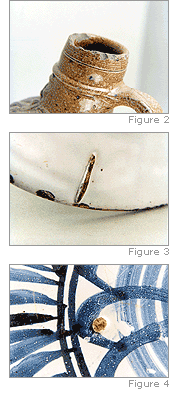 |
| Home | Articles | An Introduction to Understanding Antique Delft |
|
|
 Delftware was produced in most Western and Middle Eastern countries between the fifteenth and eighteenth centuries. Although known by many different names—faience, maiolica, galleyware, and hispano-moresque in the West, or Iznik Persian blue pottery and Egyptian faience in the Middle East—as a group these potteries are referred to as tin-glazed earthenwares. The unifying factor among these wares is that they are composed of a relatively crude earthenware clay body covered with a traditional lead glaze rendered opaque by the addition of tin oxide to the glaze formula. This glaze was developed to provide an even, smooth background that covered the uneven nature of earthenware clay. The process was very effective, with the glaze providing a ground on which decorators could paint their designs. Some unintended characteristics of the process provide details to authenticate and, to a degree, date these objects. These idiosyncrasies are illustrated in the following discussion. Delftware was produced in most Western and Middle Eastern countries between the fifteenth and eighteenth centuries. Although known by many different names—faience, maiolica, galleyware, and hispano-moresque in the West, or Iznik Persian blue pottery and Egyptian faience in the Middle East—as a group these potteries are referred to as tin-glazed earthenwares. The unifying factor among these wares is that they are composed of a relatively crude earthenware clay body covered with a traditional lead glaze rendered opaque by the addition of tin oxide to the glaze formula. This glaze was developed to provide an even, smooth background that covered the uneven nature of earthenware clay. The process was very effective, with the glaze providing a ground on which decorators could paint their designs. Some unintended characteristics of the process provide details to authenticate and, to a degree, date these objects. These idiosyncrasies are illustrated in the following discussion.
 The addition of tin oxide to a glaze prevents the glaze from binding with the clay. Because the clay and glaze do not fuse in authentic period delftware pieces, there is an extremely thin layer of glaze, basically glass, that “sits” on the earthenware clay body. This fragility increases the propensity for the tin glaze to chip, especially at the edges. The addition of tin oxide to a glaze prevents the glaze from binding with the clay. Because the clay and glaze do not fuse in authentic period delftware pieces, there is an extremely thin layer of glaze, basically glass, that “sits” on the earthenware clay body. This fragility increases the propensity for the tin glaze to chip, especially at the edges.
Figure 1 illustrates a detail of an edge chip on a delft bowl. Note the way the glaze sits on the surface of the clay. The turning lines in the clay are visible where the glaze has chipped off. For comparative purposes, Figure 2 illustrates a chip on a stoneware jug. Here the clay and glaze are fused. This is true for all pottery and porcelains except for tin-glaze potteries.
Also helpful in identifying period delftware objects are the “stilt” marks. Stilts are the small pieces of clay that keep plates and chargers separated in the kiln during the firing process so they do not touch and fuse upon cooling. When the stilts are routinely broken off at the end of the firing process, marks are left that help authenticate and date the items. Most plates and chargers of the late seventeenth through eighteenth centuries, except for the blue dash form, will show a distinctive elongated scar on the back (Fig. 3). The blue dash chargers and plates (named for their shallow bowl shape and often dash-decorated rim) produced during the second half of the seventeenth and early eighteenth centuries are fired upside down, causing a distinctive small, rounded scar on the front (Fig. 4). Both types of stilt marks are generally found in a triangular pattern (Figs. 5, 6).

While in most countries delftwares were being phased out by the 1790s in favor of creamware, pearlware, and other more durable ceramics that were less expensive to both produce and purchase, a few factories in the Netherlands continued to produce delftwares into the twentieth century. Objects made in this later time frame were often still fired using stilts, but the stilts were much smaller, generally leaving tiny marks in the same triangular pattern. Although these hints are quite helpful guides, there are exceptions to every rule, such as the razor points used in firing some petit feu (muffle-kiln fired) objects.
The addition of tin oxide to the glaze can result in some unusual chemical interactions. These factors, as well as the use of design as an aid in identifying, dating, and authenticating tin-glazed earthenware will be presented in a follow-up article.
|
|
Mark Allen operates Mark & Marjorie Allen Antiques of Amherst, New Hampshire, and has been in business since 1968. Their gallery has the largest selection of delftwares in America. Mr. Allen also serves as an advisor to museum, corporate, and private collectors on delftwares and early brass. His most recent collaboration is with the Long Beach Museum of Art in California on their current exhibition, Tulips, Pomegranates, and Kings.
Know Your Antiques is a regular feature that offers insight into the world of decorative and fine arts.
|
|
|
|
|
|
Antiques and Fine Art is the leading site for antique collectors, designers, and enthusiasts of art and antiques. Featuring outstanding inventory for sale from top antiques & art dealers, educational articles on fine and decorative arts, and a calendar listing upcoming antiques shows and fairs.
|